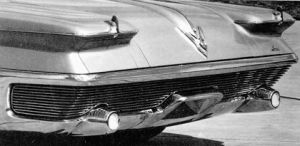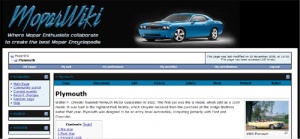Difference between revisions of "1958 Imperial D'Elegance"
| Line 4: | Line 4: | ||
[[Category:Needs Collaboration]] <!-- Remove from this category once Wiki is more than 50% complete --> | [[Category:Needs Collaboration]] <!-- Remove from this category once Wiki is more than 50% complete --> | ||
| − | [[Image:1958_Chrysler_Imperial_D'Elegance1.jpg|center|400px]] <!-- Main photo at top of page--> | + | [[Image:1958_Chrysler_Imperial_D'Elegance1.jpg|center|400px|Fins fount there way onto the 61 Imperial while tail lights were used on 62 Dodge]] <!-- Main photo at top of page--> |
{{Template:Openx}} <!-- Do not remove this line --> | {{Template:Openx}} <!-- Do not remove this line --> | ||
Revision as of 18:08, 1 April 2020
The Imperial D’Elegance dates from 1958, and Exner says that it was part of an exercise to maximize visibility, eliminating both the B and C pillars. The Lancer’s horizontally-ribbed grille, so different than the Valiant’s “classic” one, also appears to originate here.
This Wiki is Under Construction, and can use your help!
Please take a moment to add any information you might have on this topic. It is through this type of Member collaboration that the MoparWiki will grow into being the Ultimate Mopar Infobase. The links contained in the Understanding Wikis box in the sidebar can help you get started.
Contents
Background
The Imperial as a Car Make By Daniel Vaughan | May 2005
1958 Chrysler Imperial D Elegance The Imperial was designed by Virgil Exner and hailed by Chrysler as 'The Finest Car America Has Yet Produced.' A very bold statement considering some of the masterpieces produced from Packard, Cadillac, and countless others. This was Chrysler's first vehicle to have a wraparound windshield. Produced in limited numbers, only 11,430 examples were created in 1955. This was Chrysler's interpretation of a true luxury automobile.
The Imperial was a highly priced vehicle for its time, costing $4,483 for the four door sedan, over $500 more than the Cadillac Series 62. Even though it was pricey, it offered items as standard equipment that were optional on other vehicles. For example, power brakes and power steering were both included with the sticker-price of the vehicle, while other manufacturers charged extra for these luxury items. The Imperial Newport hardtop coupe sold for roughly $4,720.
A two speed automatic transmission with a 250 horsepower Hemi engine was offered for the base models.
The 1957 Chrysler Imperial is probably the most famous and popular Imperial in history. Styling was once again handled by Virgil Exner. Tailfins could be found in the rear of the vehicle. The curved door glass were not only creative, they were the first in the industry. The long, stylish front hood hid a giant 392 cubic inch V8 capable of producing 325 horsepower. The Hemi V8 version produced 350 horsepower.
In 1956, Chrysler had introduced a TorqueFlite, three-speed automatic transmission. In 1957, it found a home in the Imperial. This transmission, coupled with the V8 powerplant could propel this large, luxury vehicle from zero to sixty miles per hour in 9.8 seconds easily beating the nearest competitor. Its top speed of 125 miles per hour was also unmatched.
Three body styles were offered, they were the two door hardtop, convertible, pillared sedan, and four door hardtop.
In 1957, 35,734 Imperials were produced, the best year Chrysler would have with this vehicle. Production continued until the 1970's with both mechanical and styling changes occurring throughout the years.
In 1958, the Imperial was fitted with cruise control and electric door locks. In 1959, a new 413.2 cubic inch V8 engine was introduced, producing 350 horsepower at 4600 rpm. In 1961, large tail fins were fitted to the rear of the vehicle. This was not the first time tail fins were used on the vehicle. The tail fins first appeared on the vehicle in 1956 but they were subtle, unlike the 1961 fins that were large and commanding. Was it styling, was it more competition Was it a market that was headed towards more economically friendly vehicles, or was it simply some other reason? During the 1961 model year, Chrysler only produced 12,249 Imperials. Whatever it was, the Imperial carried a bold statement, an unbeatable powerplant, superb luxury elements, and handling that could tame and control the vehicle even at high speeds.
In 1966, the horsepower was increased again with the introduction of a 440 cubic inch V8. Better power-to-weight ratio improved the performance and handling. With 350 horsepower at 4400 rpm and 480 ft-lbs at 2800 rpm, the Imperial 440 was the most powerful luxury American automobile ever.
In 1967, 17,620 Imperials were produced.
Background of The Exner Era Dream Cars
Quick History of Exner
In 1932, A 23-year-old Virgil Exner was hired by GM's Art and Color Studio. Boss, Harley Earl immediately recognized Exner's design talent. Two years later Enxer was put in charge of the entire Pontiac Studio, a job he kept until 1939 when Raymond Lowry hired him to work on his studio's design contract with Studebaker. Exner worked with Lowry and Studebaker all through WWII, and when the highly advanced 47 Studebaker's were shown to the public in 1946, they were touted as "The First By Far With A Post War Car. It would be the 1949 Model year when the "Big Three" would catch up.
A dispute between Lowry and Exner over credit for the design of the 52 Studebaker caused Exner's firing. Studebaker wasn't impressed with the Lowry proposal for the 52s, and Exner showed them a design he'd been working on at home on his own time. Studebaker liked it and Lowry wanted credit for his employee's work. He was fired when he refused, but Studebaker picked Exner up for their in-house design team. There was little love between Lowry and Exner for the rest of each of their lives.
In 1949, Chrysler President K. T. Keller hired Exner away from Studebaker for the purpose of designing cars that would improve Chrysler's stodgy image. The Chrysler Corporation was well known for its engineering firsts, but not its styling. The Chrysler Corporation's "Small on the Outside - Big on the Inside" designs looked ancient when compared to the 49 Ford and GM offerings. Keller wanted the cars designed to where a man could drive with his hat on. This made the cars appear too tall.
At first Exner worked secretly on Advance Designs, but was soon promoted to head the studio. The model year designs were already locked in through 1954, so Exner began work on the 1955 model, the first year of the "Forward Look" designs.
Keller and Exner agreed that they should step up Chrysler's showing of Dream Cars to compete with Harley Earl's million dollar dream cars displayed in the Motorama shows. They felt this would create excitement with the public on updated designs that would hit the showrooms in the future. However, they would have to do it on a budget no where near the size GM had given Earl.
Exner and Ghia
While working on his first of the Chrysler Dream Cars, the K-310, Exner and his design team were at an impasse. On a previous trip to Italy, K. T Keller commissioned both Pininfarina and Ghia to each build a car of his loose design specs, but allowed them design creativity. The purpose was not to test their design skills, but to test them for quality, fit and finish.
Knowing that the Exner team was having trouble with K-310, Keller invited the team to view the cars that had just arrived from Italy. Pininfarina had closely followed the specs, while Ghia took great liberties with their allowed creativity. Ghia's car was very impressive. The Ghia submission was also far better in quality, fit an finish than the submission from Pininfarina. It was to became the Plymouth XX-500 show car. In addition to Ghia's craftsmanship, their design abilities were a pleasant surprise.
This began the long relationship between Chrysler and Ghia, and more importantly - collaboration between their designers.
Specific Details of 1958 Chrysler Imperial D Elegance
This wiki is severely in need of information and references. If you can improve, please do so.
Designer
- Virgil Exner. It's frequently been reported that he was never happy with the overall design of the car
Features to later appear on other Mopars
- The greenhouse and sloping trunk profile went to the '60 Valiant
- The sweepspear on the side of the car appeared on the Valiant, but going in the other direction
- The fin treatment with suspended lighting appeared on the '61 Imperial
- The dashboard appears to be virtually identical to the 61-63 Imperial
- The taillight pods (minus the fins above!) appeared on the '62 Dodge
- The eyebrows and hood shape appeared on the '60 Imperial
Chassis
Body
Interior
Drivetrain
Car Shows
Movies Appeared in
Magazine Articles
Reference
- https://www.curbsideclassic.com/blog/concept-classic-1958-imperial-delegance-the-origin-of-the-valiants-roof-among-other-things/
- http://www.imperialclub.com/Yr/1958/DElegance/index.htm
Internet Links
Random Page | Longest Wikis | Oldest Wikis | Newest Images | Newest Wikis | List of Categories | List of Every Freakin Wiki
- Register to Edit
- It takes less than 5 minutes to request registration for editing, and we try to approve within 24 hours. Click the Register Link in the Top Bar.
- MoparWiki Help
- While editing Wikis may at first glance appear a little overwhelming, it really isn't. You will find this site's HELP (link found in the sidebar) to be very strong and easy to understand. The best way to start is with small edits and working on your user page -- and you will become a Pro in no time.




